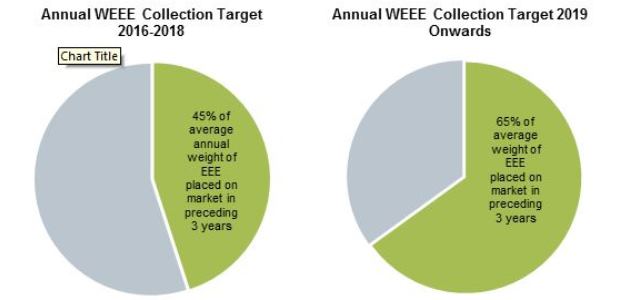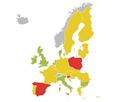
WEEE Recast Directive Update
The current product scope of 10 categories of Electrical and Electronic Equipment (EEE) will remain in place during the transitional period, Aug. 13, 2012 to Aug. 14, 2018.
The Feb. 14, 2014, deadline for EU Member States to transpose the new Waste Electrical and Electronic Equipment (WEEE) Recast Directive 2012/19/EU into national WEEE Regulations has now passed. So far, Bulgaria, Denmark, Ireland, Italy, Luxemburg, the Netherlands, and the UK have transposed the WEEE Recast Directive. Meanwhile, draft legislation to transpose the WEEE Recast has been released by 18 EEA Member States.
Products in Scope

 The current product scope of 10 categories of Electrical and Electronic Equipment (EEE) will remain in place during the transitional period of Aug. 13, 2012, to Aug. 14, 2018 (with the addition of photovoltaic panels (PV) in Category 4: consumer equipment).
The current product scope of 10 categories of Electrical and Electronic Equipment (EEE) will remain in place during the transitional period of Aug. 13, 2012, to Aug. 14, 2018 (with the addition of photovoltaic panels (PV) in Category 4: consumer equipment).
Article 2 of the new WEEE Recast Directive states that an open scope of products within six EEE categories will then apply from Aug. 15, 2018. These new categories are found in Annex III of the WEEE Recast Directive:
- Temperature exchange equipment
- Screens, monitors, and equipment containing screens having a surface greater than 100 square centimeters
- Lamps
- Large equipment (any external dimension more than 50 centimeters) including, but not limited to: household appliances; IT and telecommunication equipment; consumer equipment; luminaires; equipment reproducing sound or images, musical equipment; electrical and electronic tools; toys, leisure and sports equipment; medical devices; monitoring and control instruments; automatic dispensers; equipment for the generation of electric currents. This category does not include equipment included in categories 1 to 3.
- Small equipment (no external dimension more than 50 centimeters) including, but not limited to: household appliances; consumer equipment; luminaires; equipment reproducing sound or images, musical equipment; electrical and electronic tools; toys, leisure and sports equipment; medical devices; monitoring and control instruments; automatic dispensers; equipment for the generation of electric currents. This category does not include equipment included in categories 1 to 3 and 6.
- Small IT and telecommunication equipment (no external dimension more than 50 centimeters)
Paragraph 4 of Article 2 provides a list of equipment, with definitions, that will be exempt from the new open scope from Aug. 15, 2018.
New Definitions
Article 3 of the WEEE Recast Directive defines a distributor as any entity in the distribution chain, not only the entity that sells directly to end users. In Article 17 of the Directive, the definition of "producer" has been revised to allow a producer that has a registered business address in one EU Member State to comply through an authorized representative in other Member States where it does not have a registered business address.
Collection Targets
Member States will have to meet tougher WEEE collection targets. From 2016, Article 7 of the WEEE Recast sets WEEE collection rates that will be considerably harder to meet than the current target of 4 kilograms per person. From 2016, Member States must achieve a collection target of 45 percent of the average annual weight of EEE (both B2B and B2C) placed on the market in the three preceding years. These annual collection targets will then rise further in 2019 to a rate of 65 percent of the average annual weight of EEE placed on the market in the three preceding years or, alternatively, 85 percent of WEEE generated in that Member State. (These targets apply to the new WEEE categories.)
Derogations from the collection targets have been set for Bulgaria, the Czech Republic, Latvia, Lithuania, Hungary, Malta, Poland, Romania, Slovakia, and Slovenia in order to address difficulties faced by these Member States in meeting the collection targets. These countries must achieve at least a 40 percent collection rate no later than 2016 (rather than 45 percent) and achieve an increased rate (65 percent to 85 percent) by 2021.
Producer Registration and WEEE Reporting
To reduce administrative burdens and gain more alignments between WEEE producer registers across Europe, Article 16 of the WEEE Recast Directive requires Member States to ensure that:
- producers or authorized representatives can register and report information on websites
- a Member State's registration website provides web links to the national registers in other Member States
Different Regulatory Requirements in Each Member State
The WEEE Recast Directive is implemented through national regulations in each country. As a result, there are different requirements in each Member State.
Bulgaria
A new WEEE Ordinance was published on Nov. 7, 2013, and came into force on Jan. 1, 2014. The ordinance sets annual WEEE collection targets of 41 percent in 2016, 48 percent in 2017, 55 percent in 2018, 60 percent in 2019, and 65 percent from 2020 onwards. The derogation from collection targets has not been used fully in Bulgaria.
Denmark
Amendments to the WEEE Regulation were published on Feb. 6, 2014, and entered into force on Feb. 14, 2014. The Regulations do not contain WEEE collection targets but do introduce photovoltaic panels in a sub-category of Category 4.
Reporting of B2C EEE in Denmark must be audited by an independent third-party auditor; this requirement applies both to individually registered producers and producers who have joined a collective system. However, under the new regulations, producers with an annual turnover of less than DKK 1 million (EUR 134,000) can apply for an exemption from the auditing requirements.
The regulations also exempt compliance organizations from the requirement to provide a financial guarantee for B2C WEEE if they have a market share of more than 5 percent.
Ireland
The WEEE Regulations (SI no. 149 of 2014) were published on March 28, 2014, and came into force on March 29, 2014. The regulations allow producers to show a visible WEEE recycling fee as part of the product price at the point of sale from July 1, 2014, introduce the option of appointing an authorized representative, require distance sellers to display their WEEE producer registration number on their website, and require distributors to retain records for at least two years of the amount of WEEE taken back each year. The definition of Dual Use B2C Equipment has been clarified as "waste from EEE likely to be used by both private households and users other than private householders, shall in any event be considered to be WEEE from private households."
Italy
The Legislative Decree 49/2014 was published on March 28, 2014. The decree categorizes "waste from photovoltaic panels" as B2C WEEE if it originated from solar panel installations producing less than 10 kW. Collective systems and producers that comply individually must gain certification to ISO 9001 and ISO14001 or EMAS.
Luxembourg
A new Grand-Ducal Regulation on WEEE was published on Aug. 5, 2013. The regulation transposes the new take-back obligations on distributors and retailers in the distribution chain, as per the new definitions in the WEEE Recast Directive.
Netherlands
The new WEEE Management Regulation was published on Feb. 3, 2014, and entered into force on Feb. 14, 2014. The regulation requires EEE producers and WEEE processors to register in the new national (W)EEE Registry. The government will require producers to provide proof of suitable collection and recycling arrangements at the point of producer registration.
UK
The new WEEE Regulations were adopted on Dec. 7, 2013, and came into force on Jan. 1, 2014. They provide reduced obligations for small producers placing less than 5 tonnes of EEE on the market in the previous year and introduce a "target and compliance fee" model to replace the trading of B2C WEEE evidence by compliance schemes.
What the WEEE Recast Directive Means for Producers
Because each of the 28 Member States and EEA Members introduces different new national WEEE Regulations, manufacturers, distributors, and retailers should assess what the changes mean for them, identify any new legal obligations, and manage compliance with these new requirements.
ENVIRON can provide detailed consulting advice and robust compliance solutions to manage new producer obligations arising from the implementation of the new WEEE Recast Directive across Europe. The company will be providing complimentary webinars on the WEEE Recast on June 12, 2014. Webinar registration details will be available on B2BWEEE.com shortly.